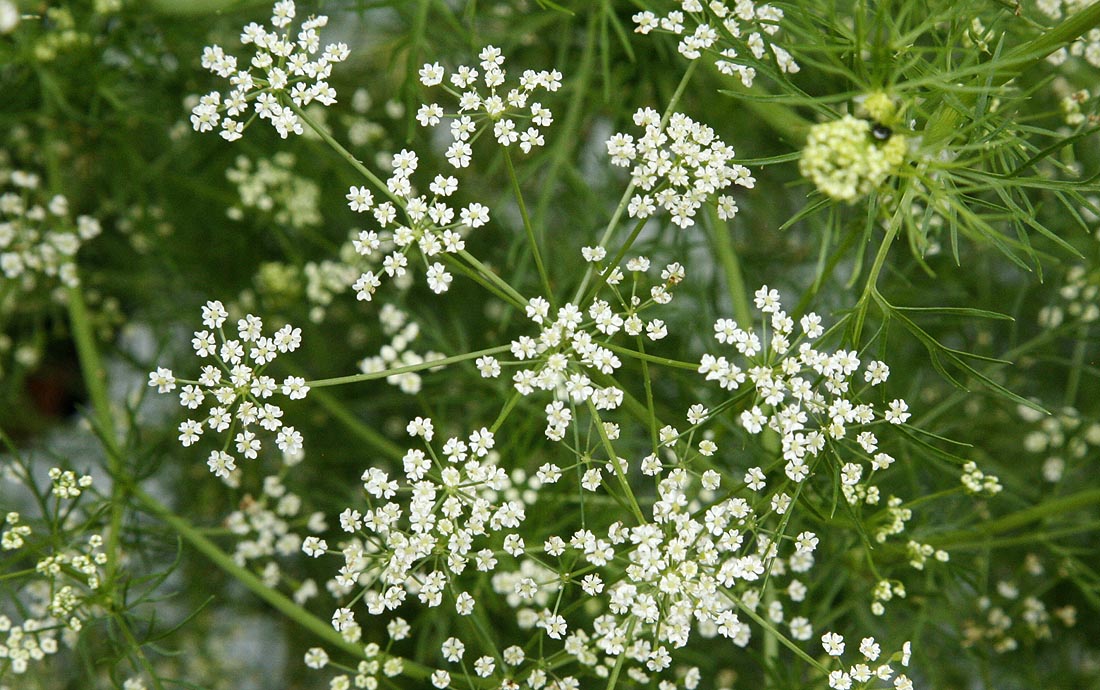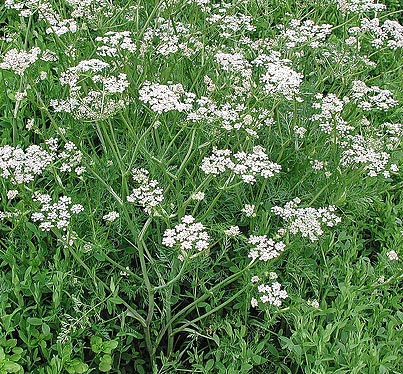Caraway is an interesting feathery plant with small white flowers. Depending on how its planted these can be sturdy plants with thick stems and strong flowers, or they can be drifting clouds of white fluffy flowers. The leaves and seeds have a lovely aroma a sweet warm aroma with a flavor similar to aniseed and fennel. The flowers have their own delicious scent that often drifts on the breeze. Adding these plants to your herb garden is very advantageous. Chewing a few seeds will aid indigestion after those over indulgent barbeques! When grown as a biennial it's very hardy surviving to zone 3 and takes a lot of punishment as long as it is watered and fed.
Caraway is an interesting feathery plant with small white flowers. Depending on how its planted these can be sturdy plants with thick stems and strong flowers, or they can be drifting clouds of white fluffy flowers. The leaves and seeds have a lovely aroma a sweet warm aroma with a flavor similar to aniseed and fennel. The flowers have their own delicious scent that often drifts on the breeze. Adding these plants to your herb garden is very advantageous. Chewing a few seeds will aid indigestion after those over indulgent barbeques! When grown as a biennial its very hardy surviving to zone 3 and takes a lot of punishment as long as it is watered and fed.
Caraway is mostly a biennial so it only flowers in the second year, however in some cases it can act like an annual. In most cases during its first year it will resemble a small feathery bush. The leaves are delicate finely cut mid green in color and arranged on the upright stem in threes or opposite pairs. During this first year the plant will produce a shallow tap root. In the second year plants that have a roots with a diameter less than ½ inch (1.2cm) at the start of the growing season are not likely to produce flowers that year but will continue to grow until the next season. Plants with larger roots will send up long grooved branching hollow stems up to two feet tall and terminate in umbels of tiny flowers that are usually white but can be yellow or green in color. It blooms in June or July. These are followed by fruits containing the seeds that are brownish in color, ribbed and slightly crescent shaped and marked with five distinct, pale ridges. They have a pleasant aroma when bruised and an agreeable taste. The leaves have the same aroma and taste as the fruit.Once the plant has flowered and set fruit it will die. In most cases this is completed in two years (biennial) however those with small roots will continue to grow and usually set seed during the third year, in some unusual cases they can live four years. Under some circumstances the life cycle can be completed in one year and the plant acts like an annual.
When planting Barely cover the seeds (about ¼ inch deep) about 8 - 12 inches apart with rows spaced at about 18-24 inches. Water well constant even moisture is important for good germination so keep the soil watered but not saturated until the seedlings emerge do not let the soil dry out.
For plug trays transplant to larger pots as soon as the roots reach the bottom of the pot, then grow on and transplant out when roots again reach the pot bottom.. If early in the season in cool weather plants can often be transplanted directly from the plug tray into rows in the ground. This must be done early in the season, so seeds should be started in late winter to very early spring.
This will allow the plants to put down strong tap roots and produce a rosette of leaves. The following year a strong stout plant with lovely flowers will be produced.
For plug trays ensure that roots are out the bottom of the pot before transplanting to small pots and growing on as describe above. Only then put in outside location (after hardening off first)
In all cases ensure that the roots are not disturbed much when transplanting.
This process stresses the plant and encourages it to flower in the first year from seed. It will produce weaker plants with finer leaves and a mound of fluffy white flowers. For drift sowing this produces the best results. These stressed plants tend not to form a large tap root and most likely wont survive for a second year. Consider them as an annual.
If you intend to harvest for leaf then grow as a biennial as forced plants have much smaller leaves. If you have a vole problem then grow as annual as the voles may eat the roots out and you wont get a second year plant.
Plants can be damaged by very cold weather 14 ° F(-10 ° C), and late spring frosts. These plants are likely to stay in a vegetative state for that year and not flower until the next season.
Once plants are established they will benefit from additional fertilizer about twice per month with a side dressing of compost about mid season to produce the best leaves and flowers.
Caraway plants can look very similar to Queen Anne's Lace in the foliage stage, so take care that you don't think you are growing weeds. In the first year since Caraway does not usually grow taller than 12 inches it is easy to spot the difference, as Queen Anne's Lace however will shoot up much taller. However in the second and possibly third year, more vigilance is needed to tell them apart.
Grasshoppers may be a pest and grasshopper body parts in the seed sample can cause down-grading or rejection. Leaf hoppers may also be of importance as they transmit aster yellows disease. Attempts should be made to prevent the spread of leaf hoppers into the caraway crop.
Seeds should be collected when they are dry on a dry sunny day to prevent any fungal problems. These can either be shaken off the seed heads as they mature or the whole seed head can be cut with snips and placed in a bag to ensure that the seeds are caught when they drop off but still have air circulation and do not collect moisture. Ripe seeds are brown in color, but seeds can be collected just before they are fully ripe and dried in the sun or over a gentle heat or dehydrator. This method ensure that reseeding does not occur in the garden. Make sure seeds are truly dry before storing in an airtight container, any moisture can produce mold on the seeds. Complete harvesting seeds before the first frost. For home use one to two caraway plants is usually sufficient to produce all the seed needed.
Roots are dug up in late fall or early winter or the first year when the most material is stored in them and they are at their largest.
The leaves are used in salads or cooked like spinach or added to stews and soups. In Germany and Austria it is used with pork, duck an goose and added to sausages.
Both leaves or seeds can be used to flavor omelets, rice and pasta dishes, cheeses and cheese spreads and vegetable dishes and is often used with apples for which it seems to have a great affinity.
Caraway seeds were customarily chewed to freshen breath. The essential oil extracted from caraway is used to flavor mouthwashes, toothpastes and chewing gums. It is also an important addition to Tunisian harissa and some blends of garam masala. The spice is very important in North Africa and the Mediterranean countries where it is a native plant.









